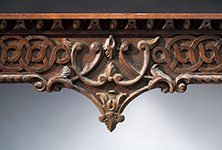For those interested in material culture, the American South has been—and for some continues to be—terra incognita. The 1952 exhibit “Furniture of the Old South” at the Virginia Museum of Fine Arts and its catalog, published in The Magazine ANTIQUES, is generally recognized as the beginning of serious scholarship in southern decorative arts. They are correct (mostly), but it is always a pleasant surprise to come upon a much earlier attempt to champion southern antiques against the bias of collectors above the Mason-Dixon line.
This summer, I received an email from Sumpter Priddy, a friend and respected antiques dealer and scholar. Attached to Sumpter’s email was the foreword to a 1923 auction catalog that immediately captured my attention for its very early attempt to promote an appreciation of furniture made in the South—nearly thirty years before the 1952 exhibit. For sale was the Mrs. Caroline Coleman Duke collection being auctioned by the Anderson Galleries in New York City. The catalog is subtitled: “The first collection of early American furniture gathered in the southern states offered by auction,” and describes Mrs. Duke’s collection as ranging from Virginia, North Carolina, South Carolina, and “going as far as Georgia.” Mrs. Duke lived in Richmond, Virginia, and was “active for years in every endeavor to preserve the traditions, historic reminiscences and art treasures of the South…” (click here to read the entire foreword).
Most captivating to me, however, were the conceptions (and misconceptions) of the early South written by the author of the catalog’s foreword, R. M. Riefstahl, Ph.D. (1880-1936), a German-American medievalist, expert in Islamic and Oriental art, and professor at New York University. Mrs. Duke’s collection is “typically Southern,” he writes, “and brings to the Northerner a distinctive flavor of an unknown land.” Dr. Riefstahl continues:
Northerners go in increasing numbers southward. The South, before the Civil War a land of romance to the Northerner, has again become the land of romance; and by a strange irony of fate, the Northerner tries to penetrate the spirit of this land and this romance by patronizing the Hot Springs and White Sulphur resorts in Virginia, Pinehurst and Asheville in North Carolina, Augusta in Georgia…[but the] real South is veiled in a Fata Morgana, a mirage that conceals what it seems to make clear. The explanation is not very difficult to find. The real South is really invisible.
Dr. Riefstahl then attempts to reveal the hidden character of the South in contrast to the North, sometimes insightfully but mostly in ways that probably offended southerners at the time—and certainly rankle our sensibilities today. (One must consider the veracity of such assessments made by a man born in Germany, who lived in Manhattan, and whose career focused on Turkish architecture and Oriental rugs.) He is clear, however, in his attempt to establish the South as new ground for antiques collectors. In the end, however, Dr. Riefstahl tempers his rallying call for a second southern incursion: “But we have not the right to direct a stream of Northern explorers to the Southern hunting grounds of Mrs. Duke.”
Over the ninety years since the sale of Mrs. Duke’s collection, the romance of the South as described by Dr. Riefstahl has not abated by one magnolia petal, but the appreciation and understanding of its material culture has blossomed. The articles in this year’s MESDA Journal are a testament to those individuals and institutions around the South who have joined Mrs. Duke to “preserve the traditions, historic reminiscences and art treasures of the South” and endeavor to dispel any Fata Morgana to make the real South visible.
I hope you enjoy the Journal. Please check back with us on occasion to read new articles as they are posted or to revisit your favorite past issues.
With best regards,

Gary Albert
Editor
[email protected]

